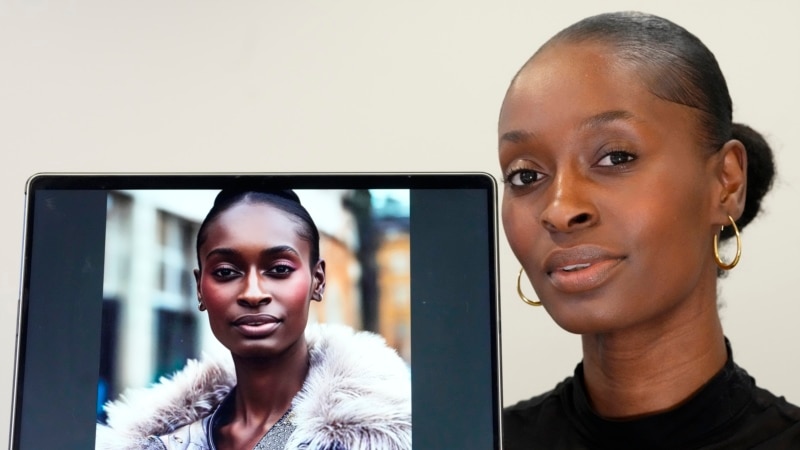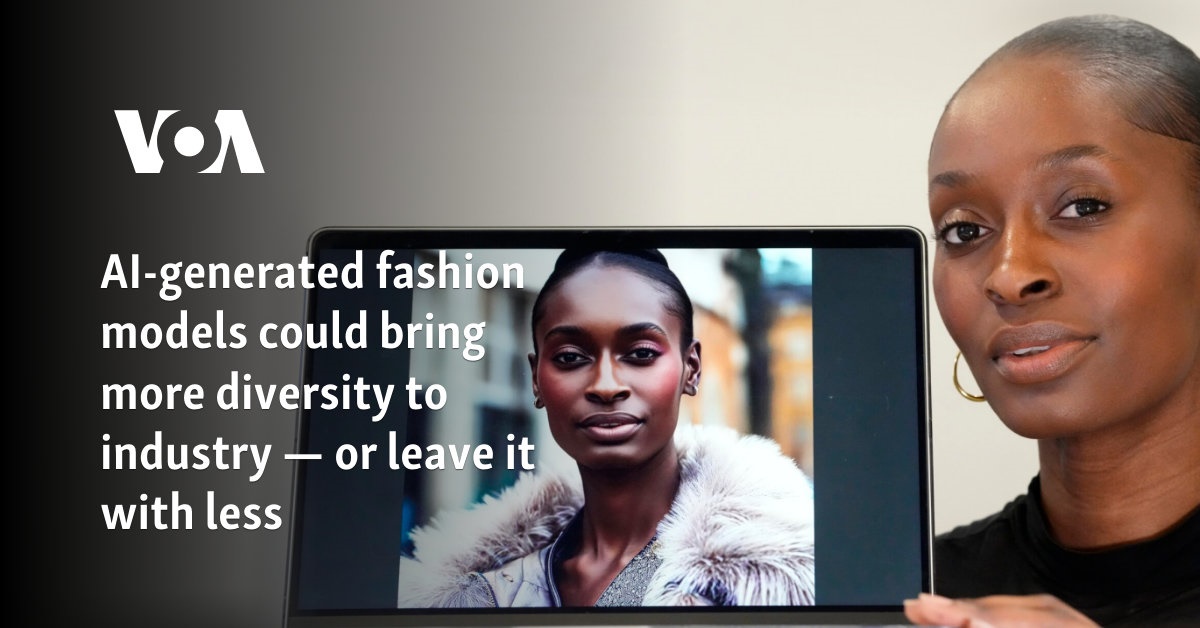
London model Alexsandrah has twins, but not in the way you think: Her twins are made of pixels rather than flesh.
The virtual twin was generated by artificial intelligence and has appeared in photo shoots as a stand-in for the real-life Alexsandrah. Alexsandrah has a career named after her, and she receives credit and compensation whenever an AI version of her is used – just like the human model.
Alexandra said she and her alter ego “were down to the baby’s hair.” This is yet another example of how artificial intelligence is changing the creative industries, and the ways in which humans may or may not be compensated.
Proponents say the increasing use of artificial intelligence in fashion models, showcasing diversity in all shapes and sizes, will enable consumers to make more tailored purchasing decisions and thereby reduce fashion waste from product returns. . Digital modeling can save companies money and create opportunities for people who want to use the technology.
But critics worry that digital models could put real models and other professionals such as makeup artists and photographers out of work. Unsuspecting consumers can also be fooled into thinking that AI models are real, and companies can claim to be fulfilling diversity commitments without hiring real people.
“Fashion is exclusionary and there are limited opportunities for people of color to break in,” said Sara Ziff, a former fashion model and founder of the Model Alliance, a nonprofit that promotes workers’ rights in the fashion industry . “I believe that the use of AI to distort racial representation and marginalize actual skin color models reveals a troubling gap between the industry’s stated intentions and its actual actions.”
Women of color, in particular, have long faced higher barriers to entry into modeling, and artificial intelligence could upend some of their gains. Data shows that women are more likely to be in occupations where technology is applied and are more at risk of unemployment than men.
In March 2023, iconic denim brand Levi Strauss & Co. announced that it would test an artificial intelligence-generated model made by Amsterdam company Lalaland.ai to add a wider range of body types and underrepresented demographics to its website. But after widespread backlash, Levi’s clarified that it would not abandon its commitment to doing photo shoots on location, using live models or working with different models.
Levy said: “We do not view this (artificial intelligence) pilot as a means to promote diversity or a substitute for the real actions necessary to achieve our diversity, equity and inclusion goals, and it should not was described as such,” he said in a statement at the time.
The company said last month it had no plans to expand its artificial intelligence project.
The AP contacted several other retailers to ask if they use artificial intelligence fashion models. Target, Kohl’s and fast fashion giant Shein all declined to comment; Temu did not respond to a request for comment.
Meanwhile, spokespeople for Nieman Marcus, H&M, Walmart and Macy’s said their respective companies do not use AI models, although Walmart clarified that “suppliers may provide Different photographic methods, but we don’t have that information.”
Still, companies that generate AI models are seeing demand for the technology, including Lalaland.ai, which was co-founded by Michael Musandu because Michael Musandu ) was frustrated by the lack of clothing models who looked like him.
“One model doesn’t represent all the people who actually shop and buy products,” he said. “As a person of color, I feel this myself.”
Musandu says his products are designed to complement traditional photography, not replace them. Instead of seeing one model, shoppers can see nine to 12 models using different size filters, which will enrich their shopping experience and help reduce product returns and fashion waste.
Musandu said the technology is actually creating new jobs because Lalaland.ai pays humans to train its algorithms.
He added that if brands “take their inclusion efforts seriously, they will continue to hire these models of color.”
London-based black model Alexsandrah says her digital modeling has helped her stand out in the fashion industry. In fact, the real-life Alexsandrah even stood in for a black computer-generated model named Shudu, created by Cameron Wilson, a former fashion photographer turned CEO of The Diigitals, a British digital modeling agency.
Wilson, who is white and uses “they/them” pronouns, designed Shudu in 2017 and described her on Instagram as “the world’s first digital supermodel.” But critics at the time accused Wilson of cultural appropriation and digital blackface.
Using the experience as a lesson, Wilson revamped The Diigitals to ensure that Shudu (which has been booked by Louis Vuitton and BMW) doesn’t take away opportunities but instead provides possibilities for women of color. For example, Alexsandrah served as Shudu model for Vogue Australia, and writer Ama Badu told Shudu’s backstory and voiced her in interviews.
Alexsandrah says she’s “very proud” of her work with The Diigitals, the company that created her own artificial intelligence twin: “Even if we’re no longer here, future generations can look back and say, ‘These were the pioneers.’ ‘”
But for New York City model Yve Edmond, the rise of artificial intelligence in fashion modeling feels more sinister. Yves Edmond is a New York City model who works with major retailers to check the fit of clothing before it is sold to consumers.
Edmond is concerned that modeling agencies and companies are taking advantage of models and using their photos to train artificial intelligence systems without their consent or compensation. Models are often independent contractors and have few labor protections in the United States.
She described an incident in which a client asked for photos of Edmond moving his arms, squatting and walking for “research” purposes. Edmond refused and later felt she had been cheated – her modeling agency told her she had been booked for a fitting, not a headshot.
“This is a complete violation,” she said. “That’s really disappointing for me.”
But without AI regulations, companies will have to be transparent and ethical when deploying AI technology. Model Alliance founder Ziff likened the current lack of legal protections for fashion workers to the “Wild West.”
That’s why the Model Alliance is pushing for legislation like the one being considered in New York state, where a provision of the Fashion Workers Act would require management companies and brands to obtain a model’s express written consent to create or use a digital replica of the model; clarify the amount of compensation and period, and prohibits the alteration or manipulation of digital reproductions of models without consent.
Alexsandrah says that with ethical use and the right legal regulations, artificial intelligence could open the door for more models of color like her. She lets her clients know she has an AI replica, and she channels any inquiries about its use through Wilson, whom she describes as “someone I know, love, trust, and is a friend of mine.” Wilson said they ensured any compensation Alexandra received from the AI was comparable to what she would have received in person.
However, Edmund is more of a purist: “We live on this amazing planet. And you have people of all colors, all heights, all shapes. Why not find that person and compensate for that Where are the people?”
Follow us on Google news ,Twitter , and Join Whatsapp Group of thelocalreport.in













